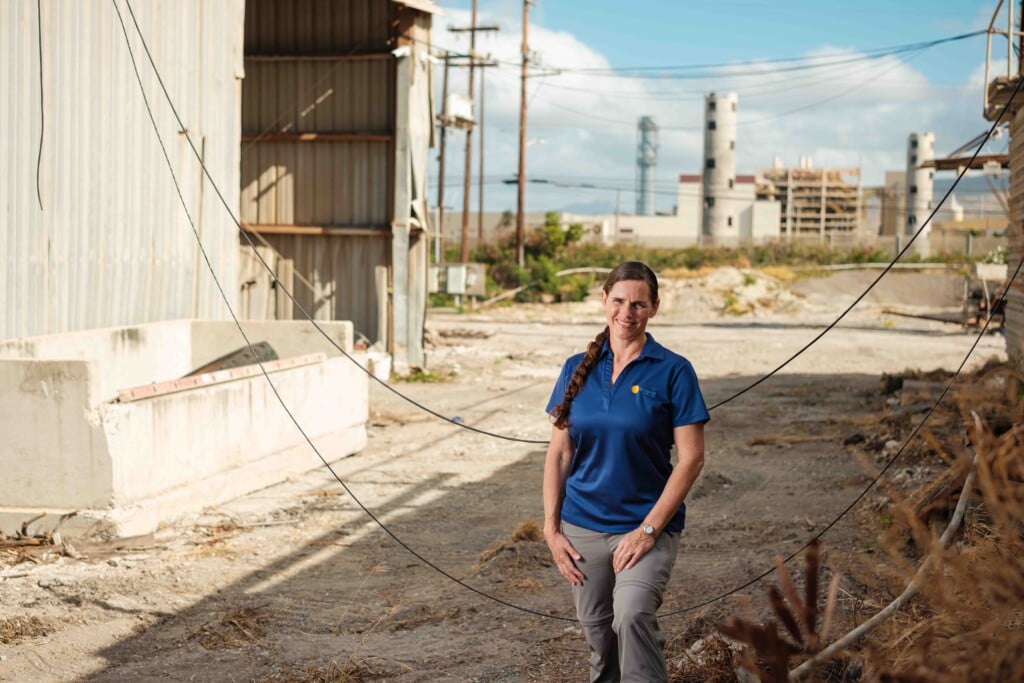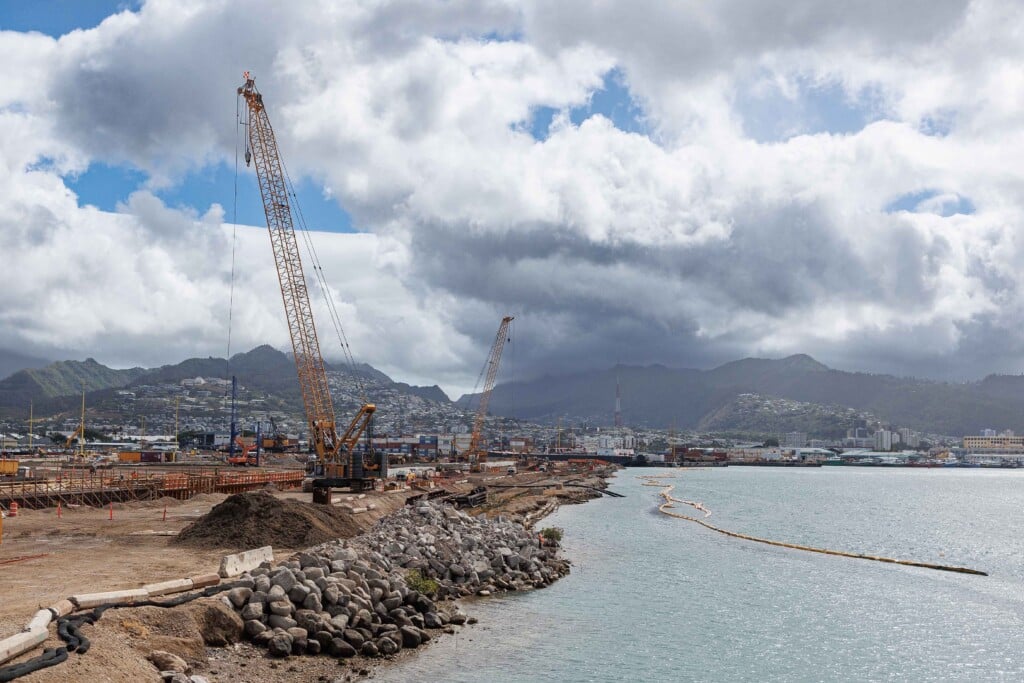How Fish Get From the Sea to Your Plate
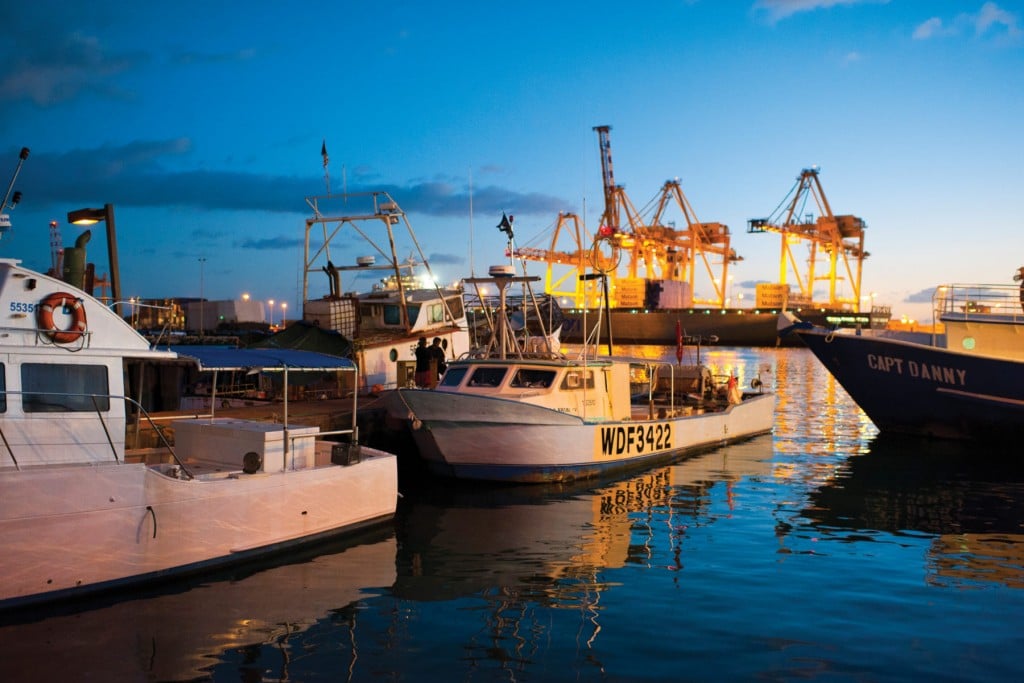
Some afternoons, after lunching on a mess of ahi furikake or fried ahi belly at Nico’s, the big fish restaurant down on Pier 38, I like to walk across the street and amble down the docks and survey the ragtag fleet of fishing boats tied up along the wharf.
Like many old sailors, I’m drawn to the waterfront. I like to listen to the Filipino, Indonesian and Micronesian crews joke and tell fish stories in the open stern houses of the boats. I like the hubbub of lading and cleaning and repair work as the boats prepare for their next trips. And I like the ceremony of mooring and unmooring, the dull shudder of the diesel as a boat springs out on a forward spring and heads off to sea, the wordless passing of lines along the quay as a returning boat ghosts into a berth. The working waterfront has always seemed to me a world unto itself, and a brief stroll along the wharf inevitably puts me in mind of older, simpler times.
But Hawaii’s fishing industry isn’t just a nostalgic relic of the past. It’s still a surprisingly important sector of the local economy, selling more than 31.7 million pounds of fish in 2012 with a total value of more than $115 million. Hawaii-based boats caught more than half of the swordfish and nearly 80 percent of the bigeye tuna landed in the U.S. in 2012. The industry directly employs hundreds of fishermen and indirectly supports a vast economy of chandleries, mechanics, electronics companies, boat yards, icehouses and fishmongers. So, although few people visit the commercial harbors at Pier 38, or Kewalo Basin, or Wailoa Sampan Basin in Hilo on Hawaii Island, Hawaii’s fisheries play a signature role in how we live. But those fisheries are also under increasing threat from environmental factors, economic pressures and regulatory changes. To understand what those threats mean for the industry, you have to understand its past and the institutions that guide its future.
Hawaiian Fishing
Hawaii loves fish. We famously eat more seafood than any other state: more than nine ounces per person per week, twice the national average. And, although we import more than 60 percent of our seafood, that’s well below the mainland average of nearly 90 percent. This is a reflection of the vigor of our fishing industry. Hawaii fishermen bring in an astonishingly diverse catch, including nearshore fish such as akule, opelu and uhu; bottomfish such as opakapaka, onaga and hapuupuu; and, most important, open sea fish (pelagics) such as mahimahi, opah and yellowfin tuna.
The most valuable catches are swordfish and, especially, bigeye tuna. These fish are so prized that most of the other pelagic fish brought to market are just incidental, albeit profitable, by-catch for the swordfish and bigeye fishermen. Bigeye tuna, the source of the best quality sashimi-grade ahi, often sells for more than $7 a pound at auction. This mix of high-value fish makes the tiny local fishing industry a national powerhouse. Although the port of Honolulu only ranked 33rd in the country for the total tonnage of fish landed last year, by value, it was the 10th largest port in the nation.
Such a big, diverse catch means there’s a wide variety of fishing boats in Hawaii. Nearshore fish are caught from skiffs, Whalers and every kind of pleasure boat. Reef fish are even caught by spearfishermen towing kayaks behind them. In the bottomfishery, fishermen mostly use poles or handlines or electric reels, and work from open, trailerable boats with big, powerful outboard engines. Many of the boats in the commercial bottomfishery are based on Maui, which is close to the better fishing grounds. But the most economically important of the fishing boats in Hawaii is a fleet of about 130 longliners based out of Pier 38 in Honolulu Harbor and out of Wailoa Sampan Basin in Hilo Harbor. These low-slung, steel-hulled boats range from 64 feet to 100 feet, by regulation the largest they can get. They’re lumbering, full-displacement boats that cruise at only seven or eight knots. Hawaii is a fresh-fish market, so that means the boats have a limited range; they rarely stray beyond a 1,200-mile radius of the Islands so they can get their catch back to port while it’s still fresh.
Fishermen will tell you that’s still a lot of ocean to cover. Sean Martin, one of the major players in the Hawaiian fishing industry, puts it this way: “If you were to go 1,000 miles north, you’d be half way to Kodiak. If you go 1,000 miles west, you’re two-thirds of the way to Midway. If you go a 1,000 miles south, you’re down in Palmyra. And if you go a 1,000 miles east, you’re half way to the mainland. That’s the range of the longline fishery.”
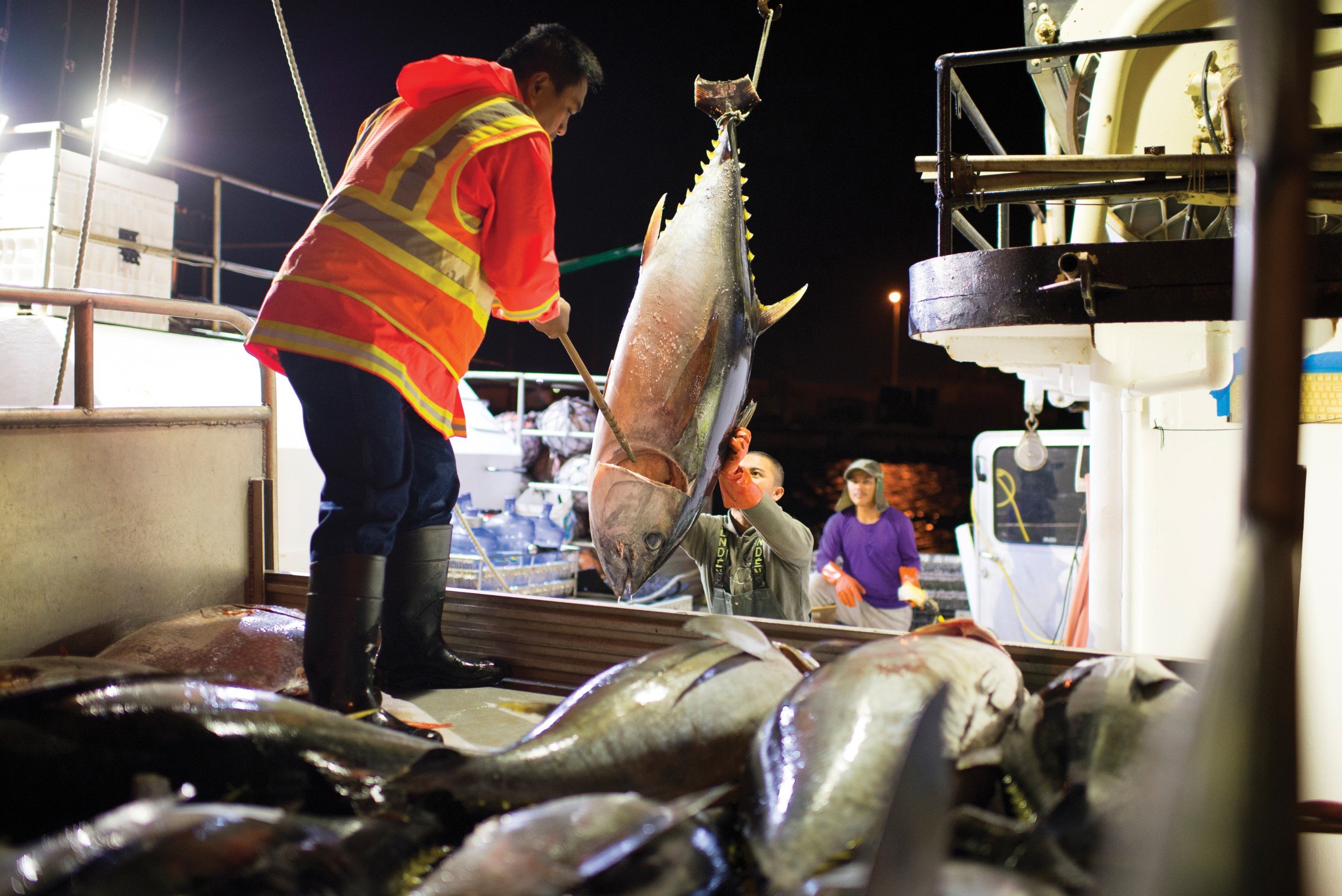
Few people see Hawaii’s fishing industry up close. Most of the fishing happens out at sea and, because the Honolulu fish auction takes place at 5:30 a.m., the catch is usually landed in the early morning hours.
Rich History
Martin has been at the center of Hawaii’s fishing industry for 35 years. At 21, he already owned his own boat, a 64-foot aku boat called Finback that he operated out of Crescent City, Calif., pole-fishing for albacore up and down the West Coast. Aku fishing is one of the most exciting commercial fisheries for a young man. The fishermen use long fishing poles with unbaited, barbless hooks at the end of a short length of line. They chum the waters with live bait, then stand in the transom, dipping their hooks into the school of frenzied albacore or skipjack, flipping the big fish over their shoulders onto the deck behind them.
Sometimes they catch hundreds in a day.
“There’s nothing more fun,” Martin says. “When you’re in your teens and 20s and you get to go around and do that, it’s not like work at all.”
But the California fisheries at the time were looking less and less viable for a boat like Finback. Then, in 1979, Hawaii Tuna Packers, a subsidiary of BumbleBee, sponsored a one-year experiment to test the viability of an albacore fishery in the Northwestern Hawaiian Islands. That looked like an opportunity to Martin, so he and Finback joined a fleet of 20 fishing boats and a specially rigged refrigerator boat that served as a mother ship and they all headed west in a flotilla.
“We left Crescent City on April 1 and basically fished two-thirds of the way to Japan.”
Martin and the rest of the experimental fleet spent the summer trolling for albacore in the NWHI, periodically transferring their catches to the mother ship so they wouldn’t have to return to port. At the end of the season, Martin brought Finback to Honolulu and, after spending the winter buying new gear and rerigging the boat, he joined the small longline fleet at Kewalo Basin.
“I started longlining in 1981 and have been involved in the longline fleet ever since,” he says.
Today, Martin and his partner, Jim Cook, own six longliners, ranging from the 65-foot Finback to the 100-foot Sea Pearl, one of the newest boats in the fleet. Martin and Cook also ownPOP Marine Supplies, the main chandlery for the longline fleet, and Hawaiian Ice, which supplies ice for most of the fishing boats, and Cook is part owner of Nico’s, the seafood restaurant. In addition, Martin serves as president of the Hawaii Longliners Associationand is the past chairman of the powerfulWestern Pacific Regional Fishery Management Council. However, he is not without critics. Martin and Cook’s boats have been fined numerous times for fishing violations, and some people have accused them of self-dealing in their official roles on the Council.
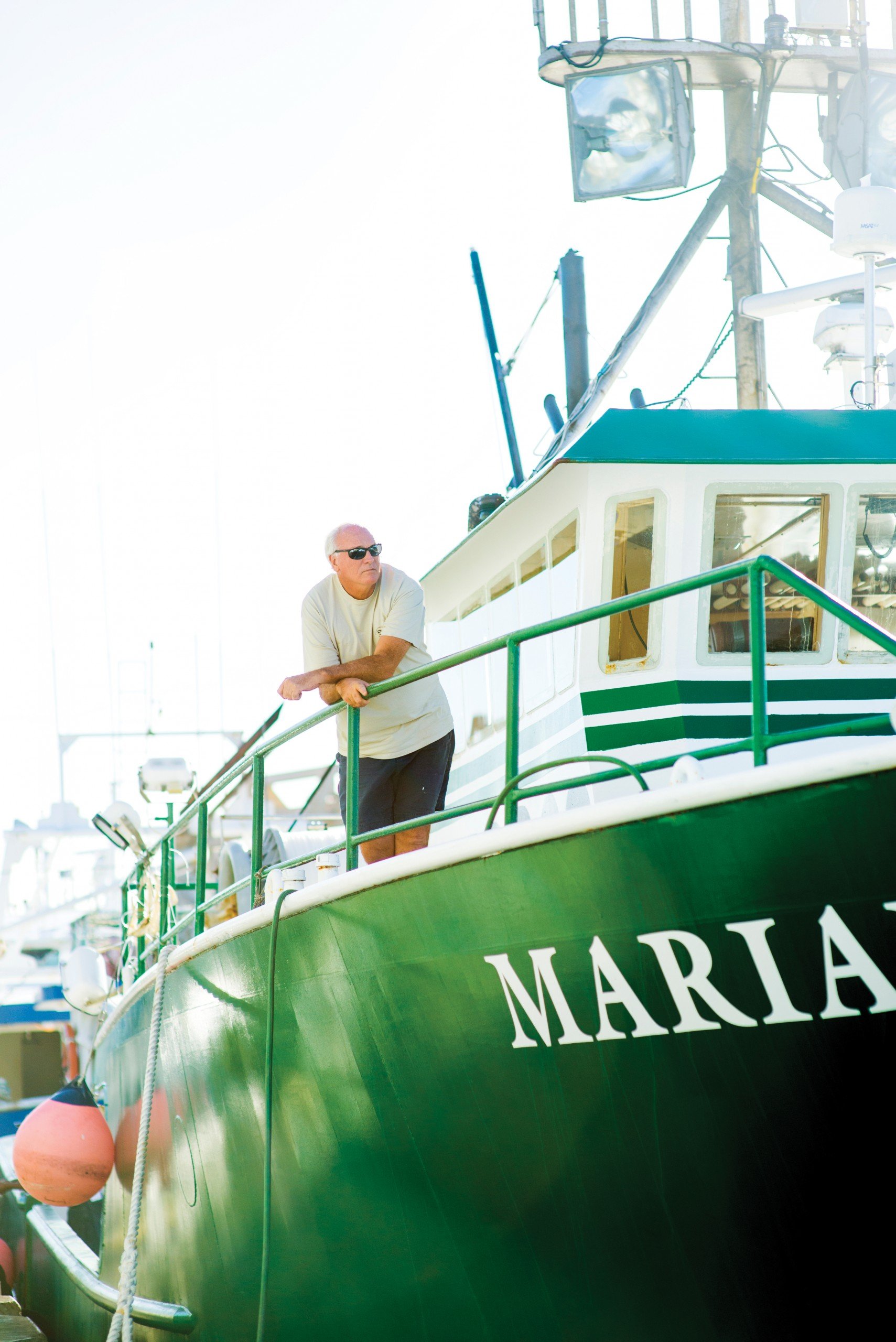
Sean Martin has been one of the major players in Hawaii’s fishing industry for 35 years. He and partner Jim Cook own six longline boats, POP Marine Supply and an ice-supply company.
Nevertheless, few people know more than Martin about longlining in Hawaii.
“Longlining was developed in Hawaii before World War II,” Martin says. “It was called flag-line fishing back then, but it’s really the same fishery, though some people might argue it’s not. The fishery was suspended during the war, because most of the fishermen at that time were of Japanese ancestry and were prohibited from going to sea. After the war, it kind of revitalized again. Most of the boats back then were small sampan boats that fished within fifty miles of the Islands. There was a pretty good-size fleet that operated out of Hilo and was supported by Suisan, the fish auction down there, and there was the fishery here on Oahu. I think the Honolulu fish auction, the United Fishing Agency, started maybe in 1951.”
The longline fishery hadn’t changed much when Martin arrived in the 1980s. Although it had absorbed a few California boats, like Finback, the size of the longline fleet remained fairly stable at 30 to 35 boats. But to ambitious fishermen like Martin, the Hawaii fishery looked like it had real growth opportunities.
That was largely because of changes in technology. “What happened,” Martin says, “was we heard about some different methodologies being used in the Atlantic, so I went to a fishing industry show in New Orleans and saw this new technology.
Rather than use what we used to call ‘traditional rope line,’ they used heavy-gauge monofilament wound up on a big drum like you can see on all these boats out here now. I bought one of these systems and brought it back and put it on Finback and it turned out to be quite efficient and effective.”
Fishermen are notoriously conservative, even superstitious, about change, but the new gear was basically a no-brainer, Martin says. “It took less talent to be effective and you could carry more gear and catch as much or, arguably, more fish than before. So we started importing that gear and providing it to people who were interested. That’s kind of how we built POP. That was in 1984, and, I think, by 1988 or 1989, all the boats had changed, with the exception of one or two, to the more modern gear.”
At that time, the thriving Hawaii fishery was contrasted by fisheries on the mainland that were overfished and under growing regulatory pressure. In the Northeast, the cod fishery and lobster fisheries seemed on the verge of collapse. In the Mid-Atlantic, the crab and oyster industries, and even the menhaden fishery, once the largest in the country, suffered from radically shrinking catches. In the Gulf of Mexico, price wars that erupted between established local boats and those owned by Vietnamese immigrants began to put pressure on the economic viability of the shrimping industry.
“Back then,” Martin says, “the longliners used to always operate out of Kewalo Basin, and one day 22 boats from the Gulf of Mexico showed up. They came in a big caravan, traveling across the Pacific from Panama. They were all Vietnamese immigrants who had been displaced by the Vietnam War and settled on the Gulf Coast. They had been longlining there for yellowfin, so it was a different fishery than ours, but they used similar gear, and I think some of the Vietnamese guys realized there was an opportunity out here, so they got together and said, ‘Go west.’ That was a kind of the explosion in the industry.”
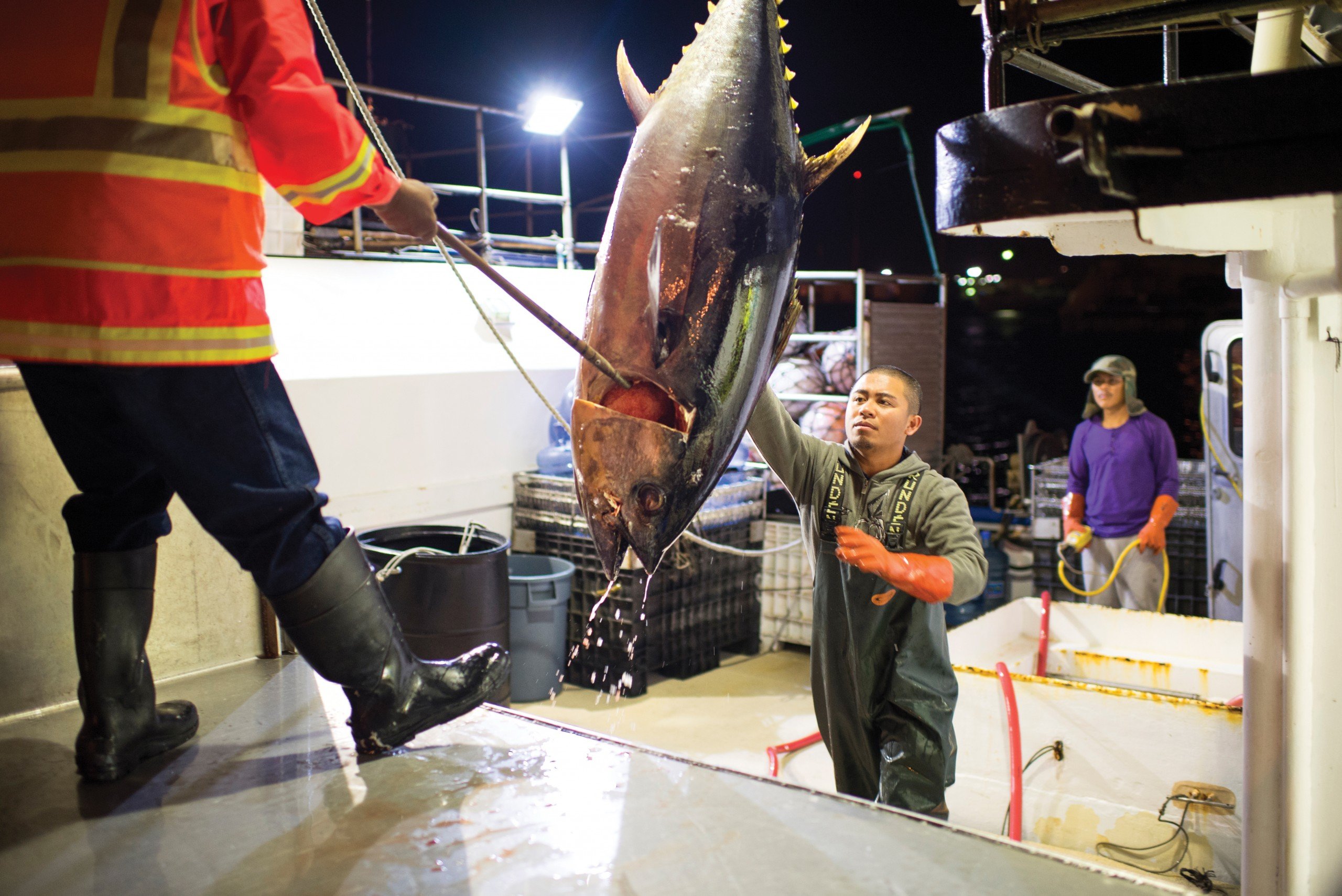
Hawaii longliners landed nearly 11 million pounds of bigeye tuna in 2012. That meant Hawaii boats caught nearly 80 percent of all the bigeye tuna landed in U.S. ports. Ahi is the name Hawaii residents use for both bigeye tuna and yellowfin tuna.
Beginnings of Change
It didn’t take long for that explosion to start having effects on how the longline fleet interacted with other fishermen, Martin says.
“When the longline fishery was relatively small – 30 or 35 boats – we all sort of did our thing. But when all these new boats started showing up, there was significant conflict between different gear users. There were ‘shots fired,’ I guess you might say.
Then, Bill Paley, who was chairman of DLNR at the time, and was on the Fishery Management Council, brokered an agreement – at that time it was called a ‘gentleman’s agreement,’ later on it became regulation – to keep the fleets separated. So, to preserve some opportunity for the small-boat guys, we entered into a regime in which there were some areas nearshore where longline boats couldn’t fish. Right now, there are still closed areas close to the Islands – 50 to 75 miles, depending on where you’re at – where longline fishing is prohibited. That was really put in place not for any scientific reason, but for keeping the fleets separate.”
By 1991, Martin says, additional regulations began to affect the longline fishery. “As the fleet grew, there was significant concern that the growth was going to get out of hand. The Western Pacific Regional Fishery Management Council, commonly known as Wespac, is the regulatory body with responsibility outside of state waters – from 12 miles to 200 miles, in theory, but it’s actually from 12 miles out to wherever boats fish. They began putting into effect management regimes to limit new entrants getting into the fishery, as well as other regulations, like vessel-size limits and those kinds of things. They started that process in 1991, and, by 1994, there was a pretty comprehensive limited-entry program for the longline fishery in Hawaii so it couldn’t grow unfettered. Today, there are only 164 permits in the fishery, and have been since 1994; so that kind of stopped the growth. But, although all 164 permits are owned, they’re not all used. They’re freely transferable, so there have been some changes over the years. Somebody gets out, retires, maybe their boat sinks, whatever. Maybe they sell their permit and somebody comes in and fills the void. Traditionally, there have been about 130 boats, plus or minus, active in the fishery for the last 20 years.”
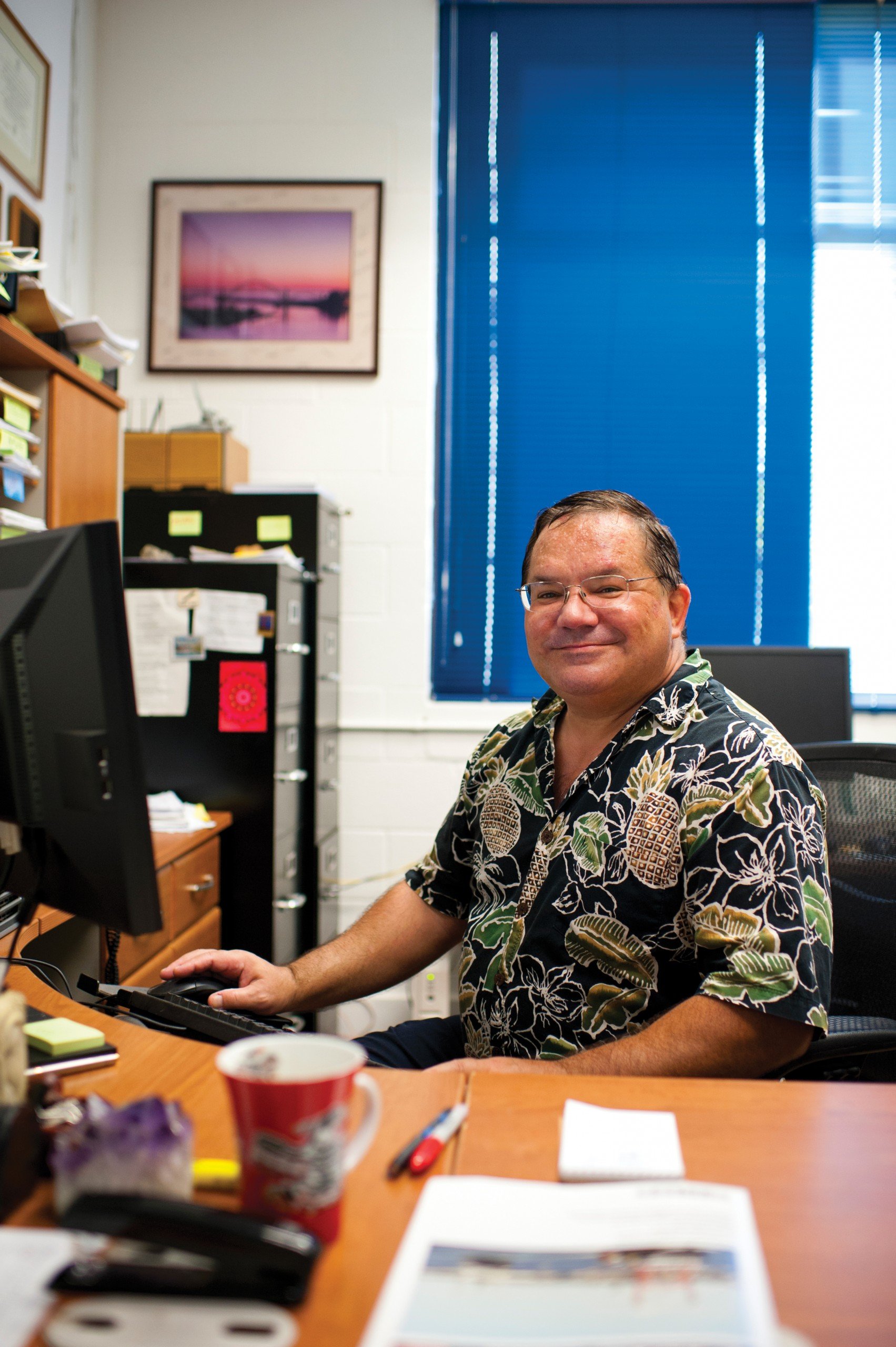
Jon Brodziak, a statistical mathemetician at the National Marine Fisheries Service, is part of the team of scientists who evaluate bigeye and swordfish stocks for Hawaii fishery.
Evolving Regulations
Despite this apparent stability, fishing in Hawaii has always been tumultuous. In recent years, most of the upheaval in the longline fishery has been because of changes in environmental regulations, particularly rules stemming from the Marine Mammals Protection Act and the Endangered Species Act. These laws have forced fishermen – historically, the cowboys of the sea – to behave like shepherds. And more and more, that has put the fate of the fishery into the hands of scientists and bureaucrats.
It started with the birds. Longliners, particularly the so-called shallow-set fishery that targets swordfish (swordfish boats need the same permit as the bigeye boats, but use slightly different gear), used to catch hundreds of albatross each year. As the fishermen baited their hooks and tossed them over the stern, the big birds would swoop in and snatch the bait, often getting snagged by the hook. Because albatross are considered an endangered species under the ESA, beginning in 2002, the National Marine Fisheries Service (NMFS), which regulates the fishing industry, required the longliners to develop new techniques to reduce the mortality rate for albatross and other seabirds.
The changes that the longliners came up with have been remarkably effective and are visible to anyone who looks at the fleet.
On most types of fishing boats, the stern is left clear to accommodate the fishing gear. Trawlers deploy their booms and nets from the stern. Trollers have their outriggers there. On aku boats, the stern is kept open to leave room for the fishermen at the transom and to accommodate the big-fish holds and live-bait wells. But on the Hawaii longliner, the stern is often conspicuously occupied by a low house built of steel or tarpaulin-covered metal tubing. Frequently, the roof of this house is encumbered with hundreds of small buoys that are used to float the line when it’s deployed at sea. They give the longliners a cluttered, yard-sale look in port.
The actual work on a longliner usually takes place amidships. The big drum of monofilament line is stowed here. As crew bait the hooks and snap the long leaders on the line, a machine called a line thrower pulls the line off the drum and sends it arcing over the side of the boat. The leaders are spaced about 110 feet apart and the line comes off the line thrower a little faster than the boat’s cruising speed, so the baited hook has time to sink in the water before it’s passed by the stern of the boat.
That’s what keeps the albatrosses from getting at the bait, and what gives the Hawaii longline fishing boat its particular profile.
Probably the most high-profile ecological problem for longliners has been the sea turtle. Much like albatross, turtles – mostly leatherbacks and loggerheads – used to target the longliners’ bait and sometimes swallow the hooks or become entangled in the lines. Before the turtles could be brought on deck, they were often badly injured and many were believed to die after they were released. As a result, NMFS forced the longliners to make more changes. They had to change their bait from squid to bait fish, like sonma or mackerel, because bait fish were more difficult for the turtles to eat than squid. They were also required to change tackle to big circle hooks, because the turtles had small mouths and were less likely to bite a big hook, and the circle hook is less likely to snag.
But the biggest change was to limit the fleet’s “interactions” with turtles. To minimize turtle mortality, the NMFS required the entire shallow-set fishery to shut down for the rest of the year once the fleet hooked or seriously injured either 17 loggerheads or 16 leatherbacks. In 2006, they reached 17 interactions with loggerheads by March 20, and in 2011, they reached 16 leatherback interactions by Nov. 18. In both cases, the fishery closed for the rest of the year. (Under court order, the swordfish fishery was also shut down from 2001 to 2004, prompting many swordfish boats to move to California.) Not surprisingly, these new regulations were highly unpopular with the fishermen, who always believed the scientists’ estimates for turtle mortality were too high and for turtle population too low.
To ensure compliance, NMFS created an observer program for the longline fishery, the first of its kind in the country. Since 2004, 100 percent of the swordfish boats – the so-called “shallow-set fishery” – have carried a NOAA observer. In the deep-set tuna fishery, there are observers on 20 percent of the boats. The observers aren’t enforcement officers; they’re there to gather data on the fishery – for example, the size, species and quantity of fish caught – and to keep track of turtle interactions and issues related to the Marine Mammals Protection Act. By law, the fishing-boat owners are required to provide accommodations for the observers. But the longliners are small boats; they generally go out with just a captain and a crew of five or six, and many owners resent the intrusion of the observers. Nevertheless, the longliners are quick to point out that, since the program was introduced 10 years ago, turtle interactions have plummeted almost 90 percent. As a result, three years ago, NMFS proposed raising the limits on turtle interactions to 34 loggerheads and 26 leatherbacks.
“We haven’t approached those numbers in years,” Martin says. “Not in interactions, let alone mortality.”
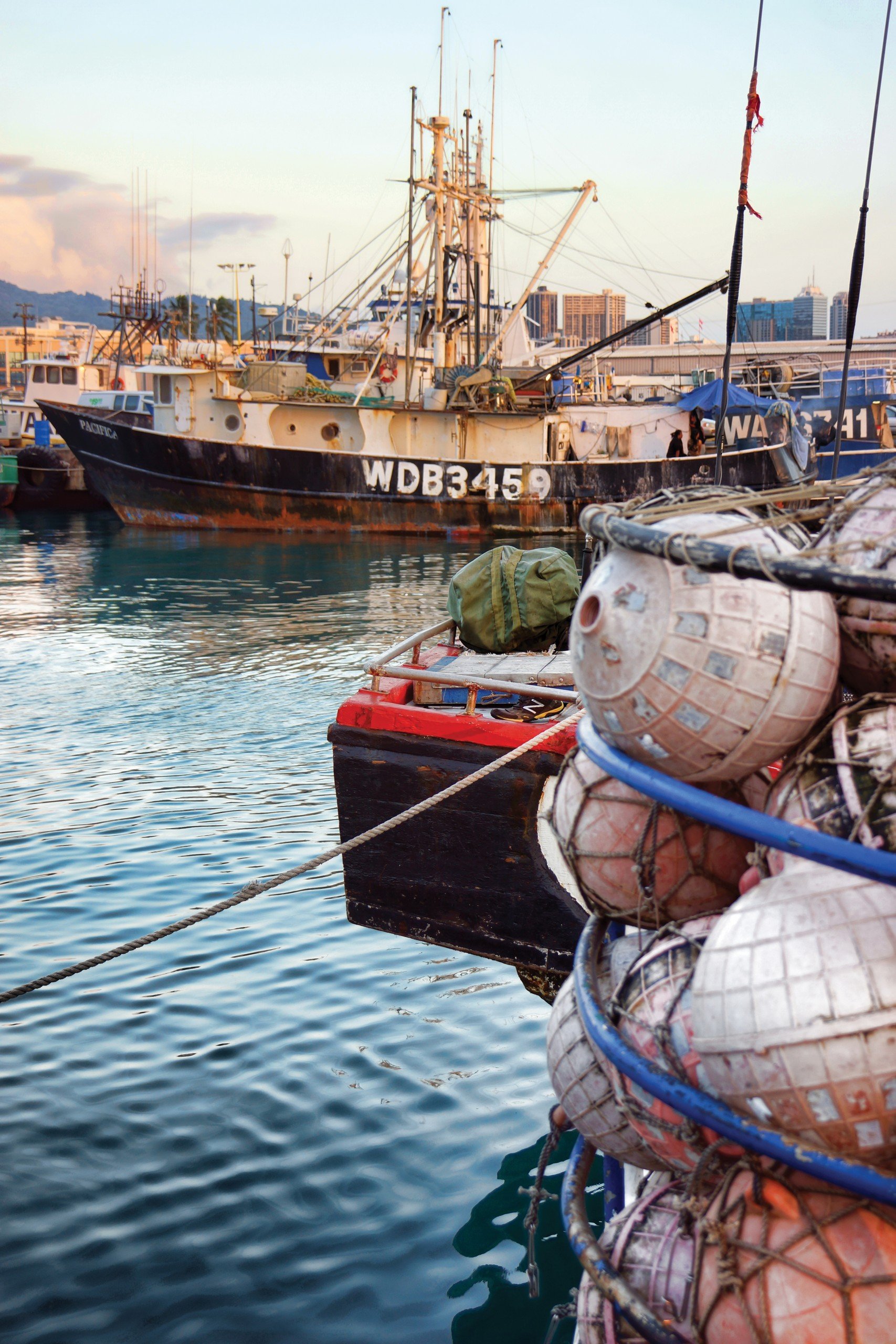
The high-quality ahi sold at the Honolulu Fish Auction is landed by a ragtag fleet of longliners based largely out of Pier 38.
Science’s View
Perhaps the most important result of the observer program has been the trove of longliner catch data. Fishery managers in other regions often have other sources of stock data. In the U.S. Northeast, for example, NMFS has its own research vessels and can conduct independent sampling to assess the stock abundance and size. (Fishermen in the Northeast, though, frequently disagree with their assessments, complaining that scientists use different gear and fishing methods than professional fishermen, so their catch data are incompatible with actual fishing conditions.) But for Hawaii waters, observer data are sometimes the only data available to fisheries managers.
One of the main uses of the observer data has been to help researchers assess the health of the fish stocks for Hawaii’s longline and bottomfish fisheries. These data are equivocal. For example, fishermen say the average size of the fish caught has remained fairly stable (albeit in slight decline), which might indicate that the fishery isn’t over-harvesting the larger fish. That’s important because fish have to reach a certain age before they can reproduce. Large fish also have lower natural mortality rates – they’re less likely to be eaten by other fish, for example. But other data suggest the total population of fish is shrinking.
Catch-per-unit-effort, or CPUE, has been slowly declining for many years. That means, for every thousand hooks set by the longliners, each year they catch fewer bigeye and swordfish.
It’s hard to know what to make of this conflicting data. Jon Brodziak, a statistical mathematician who works on stock assessment at NMFS, points out that there’s also a lot of natural variability in a complex ecosystem like the marine fishery.
“The ocean changes every year,” he says. “Productivity is up and down. The climate system is fluctuating. We have El Nino years, we’ve got La Nina years, and we’ve got mid-range years for environmental conditions.” Fishermen often point to this natural variability as the real cause of stock declines. Even as lobster stocks plummeted in the Northeast, for example, many lobstermen insisted it was a normal fluctuation in population. Fishermen in general are suspicious of scientific data of the fisheries.
Partly, that’s because of the abstract and contingent nature of science. For example, most of the stock-assessment methods rely on statistical modeling, a process many fisherman find arcane. By looking at how catch rates change through time, scientists create a sort of proxy for a direct count of fish, which, of course, is impossible. “If standardized,” Brodziak says, “the catch rate is an observation, with error, of the relative abundance. But, in this process, you also have to account for changes in the fishery through time. Those changes might include spatial effects – where you fish; they may include changes in fishing gear or the deployment of fishing gear; and they may include other factors, like which species you’re targeting. If you’re looking, say, at billfish species in the Hawaii longline fishery, we know most of the captains aren’t targeting billfish. They’re targeting bigeye tuna or yellowfin tuna, or perhaps swordfish for the shallow-set fishery. For the most part, they’re not targeting striped marlin, but that sampling is still providing us with information on the relative abundance and change in abundance of striped marlin through time.”
One recent example of how scientists use fishery observer data is an intriguing paper by Jeffery Polovina, a researcher and assistant director at NOAA’s Pacific Island Fisheries Science Center. By looking at data like catch rates, catch effort (the number of hooks set, for example), and changes in the size and types of fish caught, Polovina and his co-author, Phoebe Woodworth-Jefcoats, tried to quantify the effect of the longline fishery on the pelagic ecosystem.
“We’ve been using the 15 years of observer data from the deep-set long-line fishery,” Polovina says, “and we’ve seen a real change in the species composition and the size structure of the catch. All the real top predators of the ecosystem – the marlins, the tunas, the sharks – have been declining in relative abundance, as indicated by catch rates. The catch-rates have gone down 2 percent to 7 percent per year over the last 15 years. And what’s been coming up in catch rates are noncommercial fish, like lancetfish and snake mackerel, plus a few commercial species, like mahimahi and escolar and pomfret.” In fact, lancetfish and snake mackerel now account for more than 30 percent of the total longline catch. There’s no market for them, though; fishermen toss them back in the sea.
Fishermen like to say that the average size of the tuna and swordfish they catch has remained in the 75-pound to 90-pound range for the last decade or so. That may not comport exactly with other observations – observer data show a slight decline – but, like most NOAA scientists, Polovina doesn’t think the industry’s current fishing levels are bringing the fishery close to collapse. “Of course,” he says, “it’s sort of like predicting the stock-market collapse: It’s always easier in hindsight; sometimes you just can’t see it until after it happens. But I don’t think the pelagic ecosystem is on the verge of a collapse. There are limits on the catch. They may be too high, but they are starting to ratchet down the amount of effort in the harvest, at least for some key species, and that impacts fishing effort for the whole ecosystem. That’s a positive development. Likewise, in the bottom-fish fishery, there’s an annual catch limit also. That’s at least putting a stop to rising fishing mortality levels. If needed, we have the potential to reduce that.”
What concerns Polovina, though, is how the impact from longlining dovetails with broader ecological issues. “We’re facing a combination of top-down pressure from fishing,” he says, “and, going forward, bottom-up pressure from climate change, which we think reduces the carrying capacity of the ecosystem. That means the pelagic ecosystem is facing stress. And for now, we’re only measuring it or seeing it from the catch data. There may be other things that are changing that we’re not even seeing.
Maybe other species are changing – squid or gelatinous organisms that we’re not able to monitor – so there may be bigger effects than what we see now just looking at the longline catch.”
When Polivina presented this information, the fishermen were unimpressed. They pointed out that, even if the catch rates for bigeye and swordfish are declining, the market price for these fish is rising fast enough to keep pace. The longliners are also in the unique position that much of their “by-catch” – the mahimahi, opah and pomfret – also brings good prices in the marketplace.
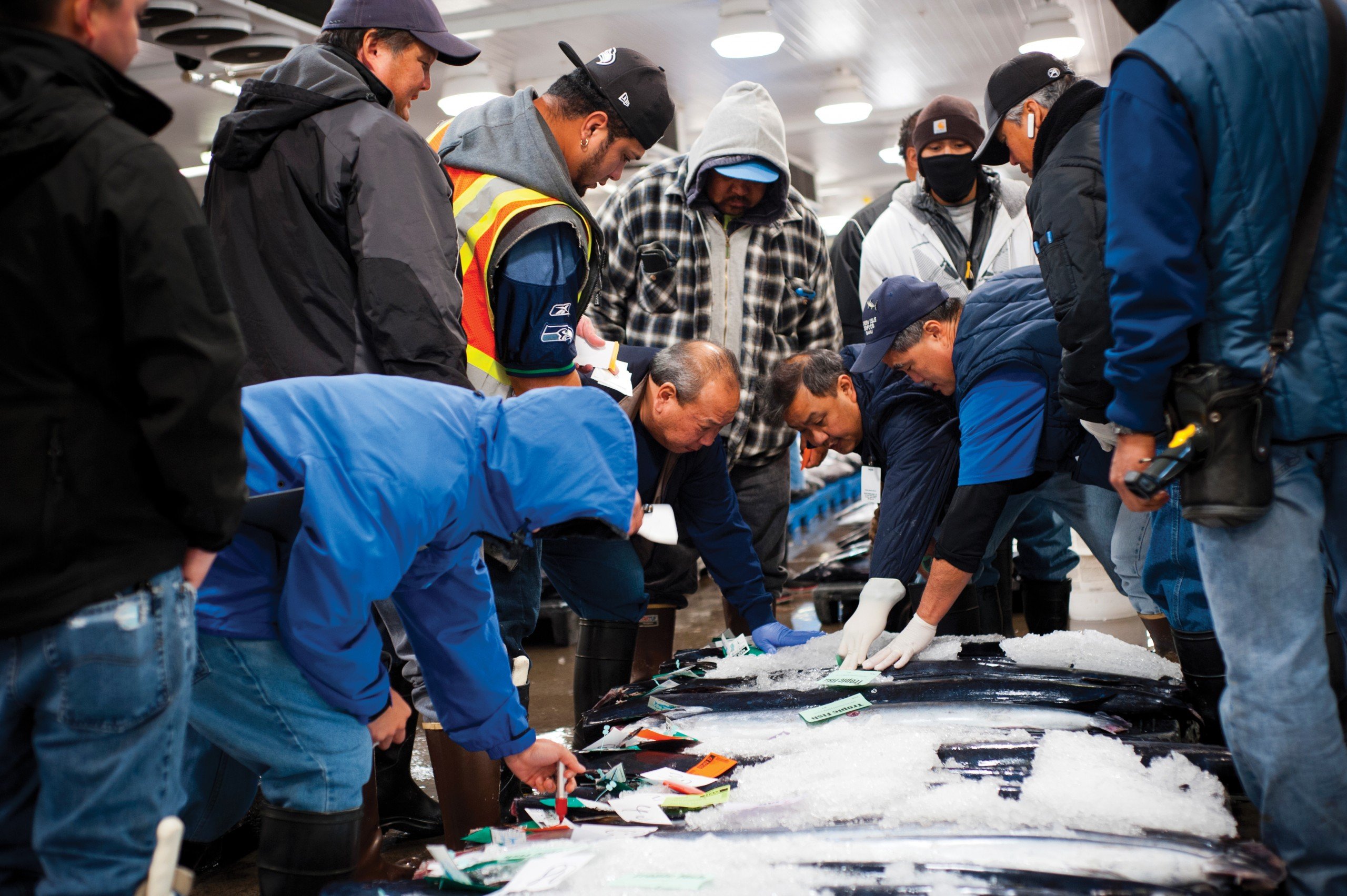
If you’re eating fresh ahi, mahimahi, opah, ono, or swordfish, it was probably sold at the Honolulu Fish Auction. Organizers say up to 160,000 pounds of fish are sold in a single day.
Environmental Criticism
For Patricia Tummons, publisher and editor of the well-regarded newsletter Environment Hawaii, this kind of industry insouciance is galling. Tummons’ coverage of the fisheries frequently gives lie to what she perceives as Wespac’s disingenuousness. One of the claims of the longliners, for example, is that, despite rumors otherwise, almost all the bigeye sold at the Honolulu fish auction is consumed domestically. In particular, they say that, although some tuna is shipped to mainland and Canadian markets, less than 1 percent is exported to Japan.
“People have this idea that the fish go to Japan,” says Sean Martin. “Really, Japan comes to us. That’s what I tell people. If you think about it, Japan comes to us in the form of tourism. Besides, Japan is a very competitive market, worldwide. There are, however, many planes a day coming into Narita or Haneda or anywhere else that are capable of carrying fish, so significant amounts of fish from other countries are coming into Japan. They don’t need Hawaii.”
But Tummons doesn’t buy it. In an editorial in the May 2012 issue of Environment Hawaii, she writes: “The notion that the longliners practice subsistence fishing and that they sell 99 percent of the catch locally, foregoing the lucrative markets in Asia and the U.S. mainland – well, they make for a good story, but no one who has seen the frenetic bidding at the Honolulu fish auction, with Japanese buyers on the phone to their Japanese clients, would give it credence.”
Tummons also scoffs at what she sees as the audacity of longliners to boast about the reduction in turtle and bird interactions, pointing out in her June 2012 newsletter that these conservation measures were enacted because of lawsuits brought by environmental groups such as the Ocean Conservancy. For example, she notes, Paul Dalzell, chief scientist for Wespac, still doesn’t believe the longline fishery ever posed a serious threat to the turtle population, and yet Wespac still wants to take credit for the changes in longline operations that were put in place to protect the turtles.
For his part, Dalzell echoes Martin and other fishery members, describing Hawaii’s longline fishery as being at the forefront of marine conservation: first in the country to enact an observer program, an early adoptee of ecosystem-based versus species-based conservation plans and a major player in the conservation of sea turtles and seabirds. All true, perhaps, but, according to Tummons, all after the fact.
More recently, Tummons has criticized the fishery and federal regulators, whom she sees as too cozy with Wespac, and longliners’ response to new regulations on the incidental taking of false killer whales by the deep-set fishery. These proposed rules, which could close as much as 150,000 square miles of ocean to longliners once two false killer whales are seriously injured, are another example of conflict between marine scientists and fishermen. Cetacean scientists believe false killer whales in the longliner fishing areas are under grave threat. Fishermen and NMFS aren’t convinced; they want more studies.
Similarly, Tummons points to a change in regulations that allows Hawaii longliners to sidestep their quota of 3,763 metric tons of bigeye by paying U.S. territories, such as Guam, American Samoa, and the Commonwealth of the Northern Mariana Islands, to cede their fishing quota to Hawaii boats. That’s how the Hawaii longline fleet continued fishing in 2012, despite reaching its limit in mid-November. According to Wespac and Hawaii longliners, this is just an exchange of U.S. fish among U.S. jurisdictions, but the truth is a little more complex. In fact, because these U.S. territories are considered Small Island Developing Countries by international law, they don’t necessarily have a firm quota. And, by Tummons’ calculation, the whole arrangement is just a ploy to avoid complying with international agreements.
But Tummons’ most vociferous complaints have been against the Western Pacific Regional Fisheries Council and the way it conducts business. Wespac is one of eight regional fishery management councils created in 1976 by the federal Magnuson-Stevens Fishery Conservation and Management Act. These regional councils are supposed to provide “science-based” fisheries-management recommendations to the Department of Commerce. Ultimately, the Secretary of Commerce must sign off on any new policy or regulation, but, in practice, regional fisheries councils like Wespac play a major role in the nation’s marine fisheries policy. For environmentalists, this has always been seen as the fox guarding the hen house. By design, most of the members of the regional fisheries councils are fishermen or tied to the fishing industry. Almost inevitably, this leads to an apparent conflict of interest. Since the principal tools of fishery management and marine conservation involve reducing allowable catches, limiting access to fisheries or cutting fishery effort, fishermen stand to lose money – at least in the short term – whenever science says a particular fishery is in danger. Environmentalists point out that fishery management councils have resisted new regulations even as the country’s fisheries have declined.
Tummons has been particularly scathing in her criticism of Wespac executive director Kitty Simonds, whom Tummons believes has repeatedly violated federal law. She has accused Simonds and other Wespac executives of failure to fully account for expenses – the fisheries management councils are funded largely through federal taxes – spending lavishly on travel and entertainment, and running the council like a personal fiefdom, holding unannounced closed-door meetings and promoting Simonds’ own agenda rather than what’s good for the fishery. In a recent editorial, Tummons stated directly: “There is still one huge step that can be taken to move fisheries management in the Pacific into the 21st century: Simonds can and should resign.”
Sean Martin, former council chair, allows that Simonds is sometimes controversial. “Kitty is a lightning rod,” he says. “But I will say Kitty is very much an advocate for fisheries. That’s her job. And you could make the argument that that’s National Marine
Fisheries Service’s job, too, but they have other pressures they have to accommodate.”
Martin also believes that environmentalists overestimate the power of Wespac. “People have this idea that the fishery council is the power in fishery regulation, but that’s not really true; they just advise. And there are proposed amendments that are rejected – that the Fishery Service doesn’t agree with, that didn’t meet some criteria or something – and it’s, ‘Thank you for your advice, but no thanks.’ But if you look at the council’s record and what they’ve done over the last 25 years or so that I’ve been involved with it, in many ways it’s so far ahead of other regions and councils. The Hawaii longline fishery was the first limited-entry program in the U.S. for a pelagic fishery. We were the first ones to have what’s called VMS – vessel monitoring systems – which means there’s a transponder that tracks the boats, so Big Brother is always watching.”
Environmentalists, of course, point out that Wespac resisted the implementation of most of these programs.
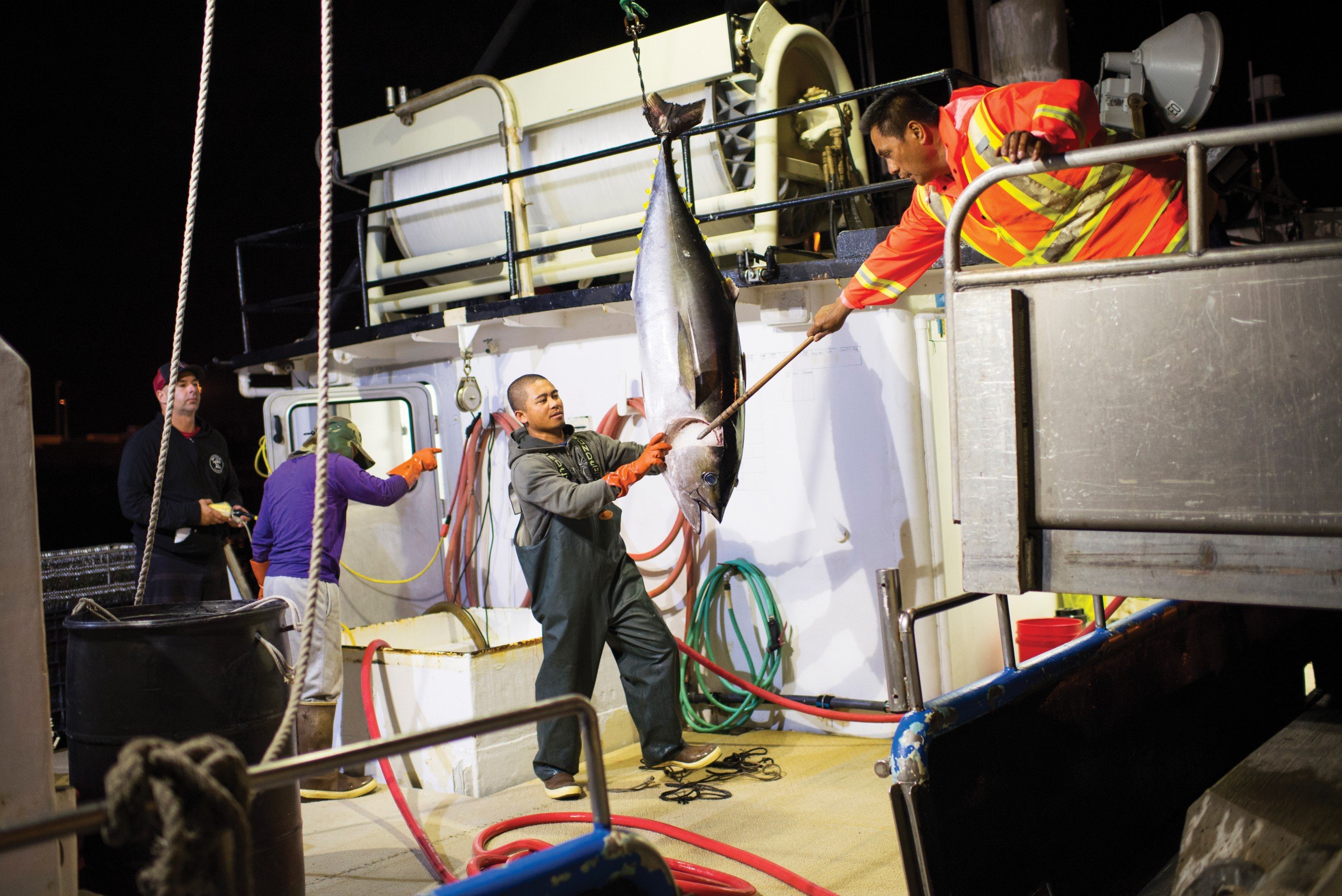
Pete Grillo is one of the newest owners in Hawaii’s longliner fleet, though he has been fishing in Hawaii for 12 years. He says fishing remains back-breaking work, but today it also requires the ability to read and interpret satellite data and other modern skills.
International Threat
All the focus on Wespac, NMFS and the Hawaii longliners misses a big part of the picture. That’s because the bigeye tuna fishery isn’t really regulated on the local or national level; by treaty, it’s regulated by international bodies like the Inter-American Tropical Tuna Commission, based in La Jolla, Calif., and especially the Western and Central Pacific Fishery Commission, based in Pohnpei in the Federated States of Micronesia. The jurisdictions of these two bodies are basically split down the middle of the Pacific, at 140 degrees longitude, and Hawaii longliners fish in both.
As a practical matter, though, the main action on the international front happens far in the West Pacific. That’s not only because the WCPFC is based there, but because that’s where most of the bigeye fishing mortality happens. Hawaii longliners, it turns out, contribute comparatively little to the total catch of bigeye. In 2011, even with the added allotment from the American Samoa fishery, Hawaii longliners only caught 4,742 metric tons of bigeye, roughly 1,000 metric tons over their putative limit.
In contrast, the purse seine fishery in the Western Pacific – mostly giant, multimillion-dollar industrial boats from Taiwan, South Korea, Japan, Indonesia and the mainland U.S. – sucked up more than 70,000 metric tons of bigeye. The remarkable thing is that bigeye isn’t even the target fish of the Western Pacific purse seine fishery. The purse seiners are mainly after skipjack, which congregate under FADs, or fish aggregation devices, and the purse seiners scoop them by the millions in enormous nets. The problem is that juvenile bigeye also congregate under the FADs, and they also get scooped up. The bigeye aren’t even really marketable for the purse seiners; they’re basically by-catch. “The purse seiners are supposed to be regulated by effort and FAD sets,” says Wespac’s Dalzell, “but the catch hasn’t come down. The annual reduction in FAD sets just hasn’t been effective.”
U.S. representatives at the recent meeting of the WCPFC in Cairns, Australia, hoped regulatory changes would shift more responsibility for the reduction in bigeye mortality to the purse seiners in the Western Pacific. The results were disappointing, Dalzell says. “That’s because the U.S. longline fishery, which is the Hawaii fishery, is going to have to take a 10 percent cut over a four-year time period. For us, we see no conservation benefit from that. Other longline fisheries are also taking cuts, but the Japanese fishery’s cut, for example, is pretty much a paper cut. They’re cut from nearly 20,000 metric tons to about 17,000 metric tons; but their fishery only caught about 12,000 tons last year, so they’re figured as reductions even though they’re already fishing well below that level. Indonesia’s limit is three times its recorded average. And, last year, Korea went well over its limit, whereas the U.S. has been assiduous in closing its fishery before it reaches its limits. So, the problem for bigeye won’t be solved until there are major reductions in the catch of juveniles in the purse seine fishery.”
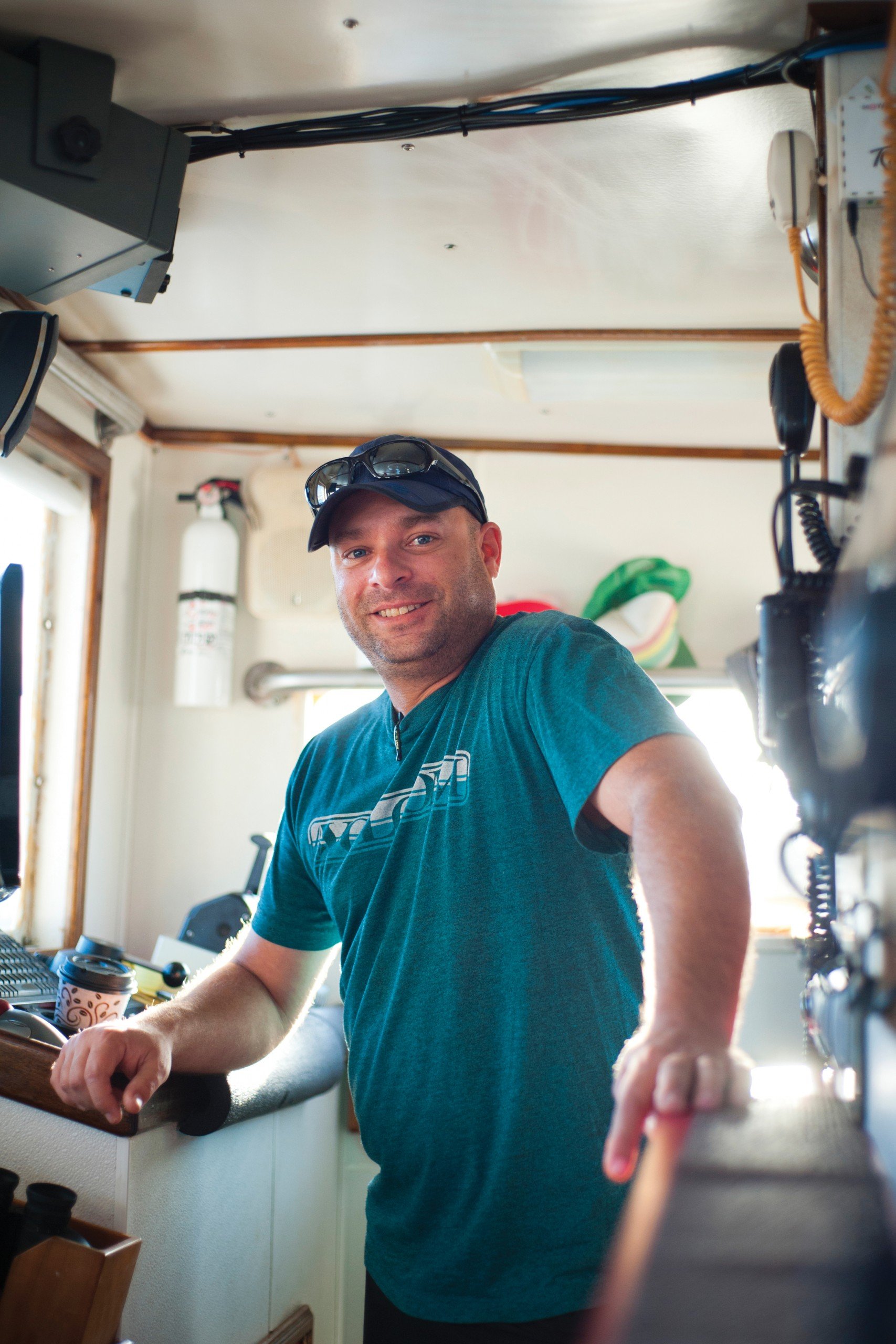
Challenges of the Sea
Of course, down on Pier 38, none of these controversies change the natural rhythms of the fishing boats. For fishermen, it’s always about the fish. That’s certainly the case for Pete Grillo, who’s been fishing in Hawaii for 12 years. He came to Hawaii from the Northeast, where he was captain of a dragger boat, but became disillusioned with fishery regulators there, and moved to Hawaii and joined the longline fleet, first as a deckhand, then as a captain and owner. He talks about the challenges facing the modern captain. It’s certainly different than the old days, when a captain depended on a thermometer and dash of luck.
Today, a captain needs to be a little more tech-savvy.
“It’s knowing how to read and interpret the satellite water data that we get. Also, having the capacity to pay attention to the details: Am I catching enough every day to stay here? Am I seeing many fish in this area or that area? Would a small move benefit me or should I take a day off and travel to another spot? There’s a lot of decision-making and analyzing your daily statistics.”
Fishing is still a back-breaking profession. “As in any business,” Grillo says, “some people want to and will work harder than others. Other people don’t want to sacrifice sleep for production. Some of us will sacrifice just about all the sleep we can for more production. On my boat, a normal workday is 18 to 20 hours. It’s about six hours to set the gear and 12 or 13 hours to haul the gear. Some of the boats might run a four-man crew on the deck; as a captain, I like to run a five- or a six-man crew plus the captain. That way I can let guys rotate out and get some sleep while still keeping the operation going. That way, everybody will get their four or five hours off a day to sleep, but at different times of the day. Guys will rotate in and out and get naps, kind of like they’re doing the swing shift. But operations are running 18 to 20 hours a day.”
But, in the end, it pays for a fisherman to remember that the sea is always in command. Grillo describes a fishing trip from four or five years ago:
“We were way out beyond the Northwest Island chain, about 800 miles above the Leeward Islands. There was a big storm coming through, but we were on some really good fish, catching 3,000 to 4,000 pounds of fish a day – nice, beautiful quality fish. At the time, there were maybe 25-foot to 30-foot seas – maybe for a couple of days, 30-foot-plus – and it was blowing 50 knots to 60 knots for well over a week.
“A lot of the guys out there were just drifting, chugging into the weather. Me, coming from the Northeast, I thought, ‘This isn’t so bad. After all, it’s still 70 degrees out here.’ So, we just kept fishing. But one night, in the height of the storm, it had been blowing 60 knots plus all day and all night, and we were hauling gear back up, coming up into the weather, when we took a really big wave over the side of the boat. I was in bed at the time and it knocked me out of my bunk. I got back up and looked out and the guys were still hauling the gear, everybody was safe, everything was still intact, the boat was still moving ahead, so I went back to sleep. The next morning, I let the guys get off the deck and have a little breakfast before we got back to setting our gear again, and I went up on the bow to look for birds or fish in the water, and saw the port bow rail was bent in about a foot or so.
“It’s amazing what the ocean can do to your boat, even the biggest of boats.”
2011 Top 10 Hawaii Food Crops
Catching BigEye Tuna
Bigeye catch and the fishing methods used in 2011:
